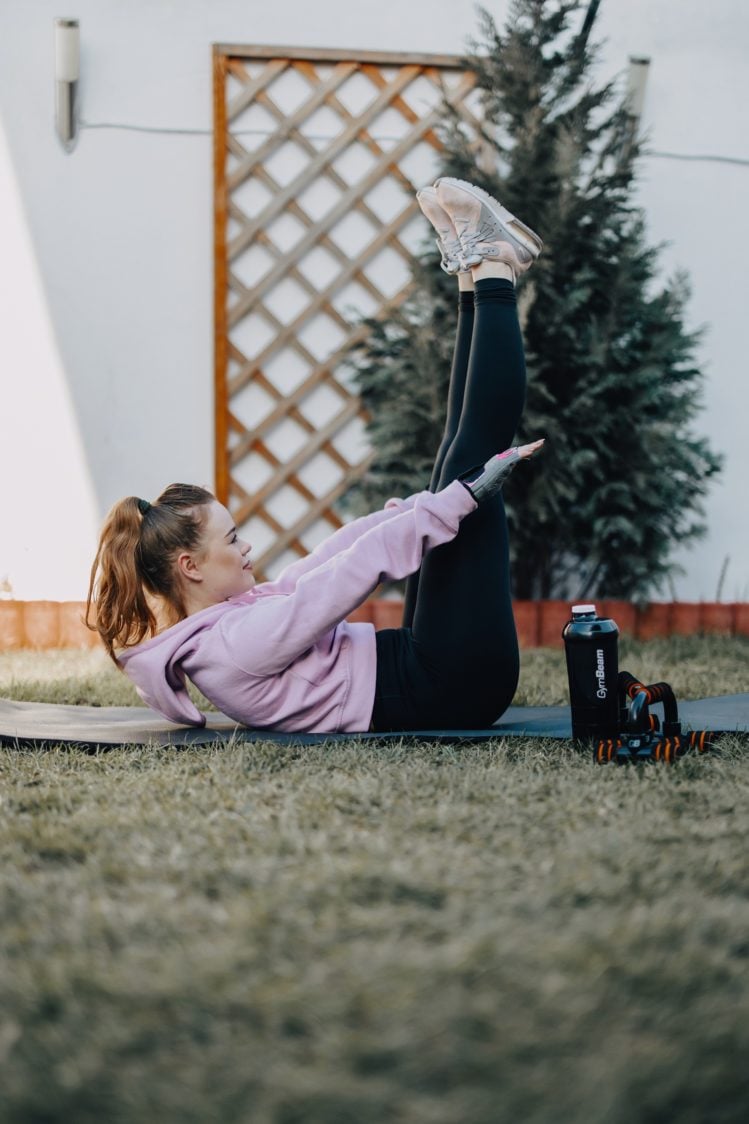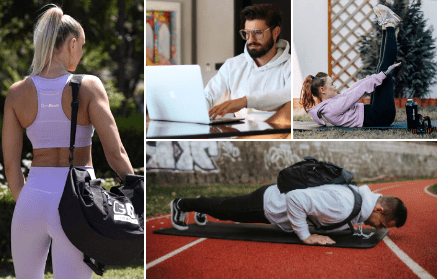Table of Contents
Sitting at the computer in this day and age can be considered almost similar to smoking, for example. We all know it’s bad for us, we promise to stretch and sit up straight as we work, but then we dive into new tasks and still squirm around in our chairs. And stretching? We successfully manage to put that out of our mind during the work day.
We won’t remember until evening, when we’re sitting or lying next to the TV again, and there’s an unpleasant back pain. It can take many forms, some suffer from lower back pain, others complain about the cervical spine. Although this pain appears trivial, they can have far more unpleasant consequences, such as severe migraines, which can keep a person out of work for several days.
But why make life miserable when pain can be prevented. And it’s not that complicated. In today’s article, we’ll tell you just how to do it.
Why sitting for long periods is dangerous

If a person sits for a long time, the likelihood of injury or other mechanical damage to the back muscles, tendons, bones or ligaments increases. When they stretch or make an unexpected move they may suddenly feel a sharp pain, a crunch, or some other unpleasant symptoms. [1]
During long periods of sitting, fatigue of the back and neck muscles also occurs, as the blood supply decreases and high tension is exerted on the spine, especially on the lower back and neck area. In addition, sitting causes the discs to compress, which prevents nourishment and can lead to premature degeneration. [1]
Overall, you may experience a deterioration in your health, physical condition, digestive issues, higher blood sugar and fat levels or an increase in body fat percentage over time due to prolonged sitting. And these are just some of the many risks associated with long-term sitting. Therefore, you should try to exercise regularly. [2]
A common problem associated with long term sitting is upper and lower cross-symptoms. These are muscular disbalances that arise as a result of inappropriate, unilateral loading of the musculoskeletal system without subsequent compensation, which simplistically means that we are still engaging some muscles in the same way and neglecting others.
The upper cross syndrome has a shortening of the upper fibers of the trapezius muscle, the erector spinae muscles and SCM muscle. You can identify this disbalance in a person by their head jutting forward, there is also an overload of the cervical and thoracic transitions and so-called upper crossed syndrome. [13] [14]
In lower cross syndrome, both the hip flexors (front of the thighs) and the torso flexors are shortened both in the large and small gluteal muscles. The way to recognise this imbalance is that the pelvis tends to move forward and there is lordosis in the lumbar cross area. In addition, it also leads to change in gait coordination. [13] [14]
What type of pain can trouble us?
Back pain can be divided into 2 types:
- pain in the lower back
- pain in the upper back
For both types of pain, it is necessary to recognise during treatment whether these are acute or chronic problems. In the first instance, it is a pain that will plague you for a matter of hours, days at the most and, at a maximum, a week. Chronic pain usually lasts for more than three months and can stay with you for life. It is even possible for acute problems to become chronic over time, so you shouldn’t underestimate any pain, but rather address the cause as soon as possible.
Factors that affect back pain
Back pain, like many other health problems, affects many factors. Some of them are in one’s control, some are not. If possible, one should do their absolute best to prevent back pain and avoid long-term problems. What factors, besides sitting for a long time, affect back pain? [3]

1. Age
The first major problems with back pain occur in most cases between the ages of 30 to 50 and become more frequent as we age. There is a gradual loss of bone strength due to osteoporosis and a simultaneous decrease in elasticity and muscle tension. In addition, intervertebral discs lose elasticity with age, which reduces their ability to cushion vertebral shocks.
Physical activity also has a major impact on bone strength in relation to slowing down these degenerative processes and preserving our health into old age. [3]
2. Physical condition
People who are less physically fit have more frequent back pain. This is mainly due to weaker back and abdominal muscles, which then cannot provide proper support for the spine. It is therefore advisable to include activities that strengthen the muscles when you are sitting at your computer during the day. You can exercise the core of your body comfortably at home. In case you decide to catch up on all your activity over the weekend and overload muscles, you will go back to facing the same pain.
3. Weight
Rapid weight gain can have a negative effect not only on health, but also on back pain. Your muscles won’t be ready to carry more weight, which will also bring back pain. Being overweight or obese for long-term has the same consequences.
4. Genetics
Some back problems that cause pain can also be genetic. Examples include various forms of arthritis or scoliosis. If you know that you have a disposition to this, it is good to focus on pain prevention all the more and consult an orthopaedist or physical therapist. The sooner you start, the more likely you are to avoid it. [4]
5. Stress
When a person is stressed, their muscles are much more tense than in the case of being calm and at rest. This tension can then also lead to pain. As far as possible, you should try to eliminate especially long-term stress from your life, which goes hand in hand with other chronic diseases.
You might be interested in these products:
6. Smoking
When we mentioned at the beginning of the article that sitting for long periods of time is similar to smoking, we must also draw attention to the dangers of combining these two activities. In addition to the risk of thrombosis and heart attack, you are more likely to experience back pain if you spend your days sitting and regularly smoking. Do you feel like it’s unrelated? The opposite is true. Smoking impairs the flow of blood and oxygen to the discs, which can cause them to degenerate more rapidly and thus cause pain.

7. Unilateral strain
Unilateral loading of one half of the spine leads to asymmetry of the muscles, which can result in back deformations. This excessive load on one side is quite common in sports such as tennis squash and the like, where the player holds the racket mostly in one hand. For these activities, the unilateral load needs to be compensated.
However, overloading of one half of the back may also occur when carrying a handbag. Women are usually used to not changing their shoulders, and considering what’s in their purse, it can be quite a load. Try to change hands or shoulders regularly, even if you are carrying groceries or a gym bag.
And now that we know why sitting for long periods of time are dangerous for us, what types of back pain exist, and what factors affect it, we can finally look at 7 tips to help us either minimize back pain or get rid of it altogether.
1. Focus on correct posture
It doesn’t matter if you’re sitting or standing, for both activities, and indeed for sports and other activities you’re engaged in, you should be mindful of correct body posture. In short, we will describe what the correct posture and seating should look like.

How to stand correctly [5]
- Whilst standing, try to stretch to a height so that the body is upright.
- Push your shoulders back and try to pull your stomach in.
- Keep your head level and your neck and chin should be held at 90 degrees.
- Allow your arms to hang loosely at your sides.
- Keep your legs approximately shoulder width.
How to sit correctly [5]
- Keep your feet on the floor, don’t cross them. If you cannot reach the ground, use an underlay.
- The calves and thighs should have an angle of approximately 90 degrees at the knees. The same angle should be between the thighs and torso, as well as between the forearms and arms.
- Keep your shoulders relaxed and your elbows close to your body.
- Keep your back propped up. If you have a chair without lumbar spine support, use, for example, a pillow to maintain support.
- If you are working at a computer, keep your head level and try to keep the screen at eye level so you do not lean towards the computer.
2. Change positions

Even if you seated in the most ideal position all day, your body can become stiff and sore. The ideal solution is therefore to change positions, stretch and perform similar activities that make the body move at least a little. Even the most busy person should get up regularly (preferably every hour) for at least a minute from work and stretch the body lightly.
There is nothing to stop fitness enthusiasts from doing a mini workout in the form of a series of squats or push-ups. And if work permits, try incorporating mobile meetings which involve walking into your day. You don’t have to sit on a phone call with colleagues, especially if your job involves a little creativity. Such a half-hour mobile meeting will get the blood pumping, and it will help you mentally function better. [6]
3. Diet
Diet affects almost all aspects of life, so it is important to mention its value in this context as well. As mentioned above, rapid weight gain, being overweight and obesity are common causes of back pain. Therefore, you know how easy it is to gain weight when you work all day and have minimal exercise. You can get a basic overview of how calories and macronutrients work from the article How to Calculate Energy and Macronutrient Intake for Weight Loss or Muscle Gain.
However, if you don’t want to burden yourself with counting calories, and would still like to improve your diet, stick to the following simple advice:
- Don’t overeat and stop eating before you’re completely full.
- Eat 3 main meals and top them up with snacks as needed. Try to avoid nibbling during the day, as even these calories count.
- Make sure you have a source of protein in every meal, such as dairy products, meat, vegetable meat substitutes and the like. Read more about protein sources in the article 20 Foods, with Which You Can Easily Add Protein to Your Diet.
- Do not forget complex carbohydrates (e.g. whole grains) and healthy fats (e.g. nuts, extra virgin olive oil, omega-3 fatty acids).
- Try to eat as few processed foods as possible.
- Eat 400g of vegetables and 200g of fruit daily.
- Ensure adequate dietary intake of manganese, calcium, vitamin C, vitamin D, vitamin K and zinc. All of these substances contribute to bone health.

4. Ergonomic equipment
It really isn’t worth scrimping on a bed or office chair. Since a person spends approximately eight hours working, not counting the extra time we use to surf the Internet, it is necessary to choose a high-quality ergonomic chair that will provide sufficient back support.
Focus on having a chair with the following: [7]
- adjustable height – so that you can reach the ground and your knees are at an angle of 90 degrees
- Sufficient depth and width of the seat – one should be able to sit with their buttocks directly to the backrest, a gap of approximately five to ten centimetres should remain between the bend in the knee and the chair
- backrest with lumbar support to provide sufficient support and a headrest that can be used during swinging
- support for the arms, which relieves not only the hands themselves, but especially the back of the neck
- mechanisms that allow rocking, moving and turning of the chair, which facilitates movement around the office, but also allows active sitting
Also, do not ignore the quality of your mattress, as you should spend eight hours a day sleeping. The mattress should be firm enough to support the spine. Keep in mind that its lifespan is approximately 8-10 years. So if you have a mattress from childhood, you’re in your thirties, and you’re suffering from back pain, maybe it’s time to purchase a new one. Likewise, you should consider purchasing an ergonomic pillow.
In case of back pain, it is good to also focus on the position in which you sleep. You have to try out what’s best for you. However, with back pain, it may be advisable to sleep on your back with knee support to ensure a neutral curvature of the lower back, or on your side with a pillow between the knees. However, sleeping on your stomach is not recommended, due to excessive strain on the cervical spine. [8]
5. Undertake regular physical activity
Regular physical activity, like diet, has a positive effect on many aspects of life. After long periods of sitting, it helps to get your stiff body moving, and if you also do strength training, you may feel in a relatively short time that your muscles support your spine much better. You’ll have a better attitude, and your back will hurt less. According to comprehensive research, cardio activities such as swimming, walking or cycling performed in moderate intensity also have a positive effect on back pain. On the other hand, it is not advisable to engage in intensive activities such as tennis, golf or horseback riding if you have knee pain. [9]

In connection with movement, it also needs to be mentioned that you should also try back pain relief exercises even at home. With these, you can strengthen and stretch the flaccid muscles. Just pull out a mat and get on with it. If you don’t have your doctor’s advice on which exercises are right for you, you can try some from our article 20 Back Exercises to Help with Back and Spine Pain.
In case you are suffering from the above mentioned upper cross-syndrome, put in place suitable balancing exercises, which will focus mainly on relaxing the chest, cervical spine and shoulders. Do not forget to stretch the pectoral muscles, neck, upper part of the trapezius, shoulder blade elevators or erector spinae muscles. [13] [14]
In case of lower cross-syndrome, focus on relaxing the pelvic, hip and lumbar spine areas. However, do not forget to stretch the flexors of the hip joint (front of the thighs), lumbar spine and quadrilateral lumbar muscle. Furthermore, try to strengthen the core muscles, abdominal muscles, pelvic floor and gluteal muscles. [13] [14]
6. Maintain psychological well – being

If you ever feel stress at work, deliberately try to stop and consider what position your body is in right now. You’re hunched over a computer, your head’s tilted, your neck stiff, and the rest of your body is feeling the strain? From this position, not only your back, but also your head can cause pain, both due to stress and poor position of the cervical spine. Stress-related back pain has been confirmed via research in adolescent girls aged 12-16 years. [10]
For example, yoga can help with reducing stress and lower back pain, and if you feel that this activity is not for you, try to practice mindfulness meditation, which teaches you to consciously experience the present moment. Make yourself comfortable and concentrate on your breathing. Try not to think about anything and push any incoming thoughts into the background. If you can’t, try counting inhales and exhales. In this way, you will learn to control your thoughts and thus reduce stress. [12]
7. Find a specialist
If you’ve been trying to eliminate the causes of your back pain, and yet it still bothers you, maybe it’s not a bad idea to go to a specialist. In some cases, a massage from an experienced masseur will help, but sometimes you can’t do without the help of a doctor or physiotherapist who will advise you on what to do next. In case of acute pain or a blocked cervical spine, your pain may be relieved by injecting or taking pain medications that are not freely available at the pharmacy, and they may suggest other solutions to the problem. [3]
What should you remember?
Nowadays, when a large part of the population spends many hours sitting every day, pain is nothing out of the ordinary. But why be miserable when we can influence and control much of it? If you don’t know where to start, try slowly observing the way you stand or sit and focus on correct posture. Moreover, you should consider buying an ergonomic chair, and try not to sit in it all day as you should take regular stretching breaks. And you should remember about the importance of diet, exercise and stress reduction. All of these factors can also help to relieve back pain. And if you feel like you can’t get a hold over back pain on your own, don’t be afraid to ask a specialist for help.
Do you also have problems with back pain during long periods of sitting? If so, share your tips on how to get rid of it. And if you found the article beneficial, share it with your friends. Perhaps this problem troubles them as well, so you can help them too.
[1] Canadian Centre for Occupational Health and Safety - Health and Safety Report – https://www.ccohs.ca/newsletters/hsreport/issues/2010/03/ezine.html
[2] Mayo Clinis - What are the risks of sitting too much? – https://www.mayoclinic.org/healthy-lifestyle/adult-health/expert-answers/sitting/faq-20058005
[3] Low Back Pain Fact Sheet - – https://www.ninds.nih.gov/Disorders/Patient-CaregiverEducation/Fact-Sheets/Low-Back-Pain-Fact-Sheet
[4] Kostuik JP - The incidence of low-back pain in adult scoliosis – https://europepmc.org/article/med/6455747
[5] MedlinePlus - Guide to Good Posture – https://medlineplus.gov/guidetogoodposture.html
[6] Keinänen - Taking your mind for a walk: a qualitative investigation of walking and thinking among nine Norwegian academics – https://link.springer.com/article/10.1007/s10734-015-9926-2
[7] Choosing the Right Ergonomic Office Chair – https://www.spinehealth.com/wellness/ergonomics/office-chair-choosing-right-ergonomic-office-chair
[8] Journal of the ACA - Proper Sleep Ergonomics – http://www.morgantownchiropractor.com/wp-content/uploads/2016/03/Sleep_Ergonomics.pdf
[9] Ribaud a kol - Which physical activities and sports can be recommended to chronic low back pain patients after rehabilitation? – https://www.sciencedirect.com/science/article/pii/S187706571301292X
[10] A.C.M. Diepenmaat, M.F. van der Wal, H.C.W. de Vet and R.A. Hirasing - Neck/Shoulder, Low Back, and Arm Pain in Relation to Computer Use, Physical Activity, Stress, and Depression Among Dutch Adolescents – https://doi.org/10.1542/peds.2004-2766
[11] Hartfiel a kol.- Yoga for reducing perceived stress and back pain at work – https://academic.oup.com/occmed/article/62/8/606/1441276
[12] Khoury - Mindfulness-based stress reduction for healthy individuals: A meta-analysis – https://www.sciencedirect.com/science/article/pii/S002239991500080X?casa_token=-Yp4_Zc9ph8AAAAA:xGzm3XRPrEY0TZ9-7j23YiBxKaHG40Pt-J2eqWTdYtwS6OTSXxDSNCQjS0CkbPSZaudFFvHHYQ
[13] Oslabení pohybové soustavy – https://is.muni.cz/do/fsps/e-learning/ztv/pages/05-oslabeni-pohyb-text.html
[14] 2.4 Svalová dysbalance (svalová nerovnováha) – https://is.muni.cz/do/rect/el/estud/fsps/js17/bodystyling/web/ch02_s04.html


Add a comment